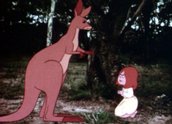

Dot and the Kangaroo (1977)
Synopsis
Dot, a small child, becomes lost in the Australian bush after she wanders away from her parents’ farm. She falls down a gully and wakes up to find a large female red kangaroo tapping her on the shoulder. With the aid of some magical food, Dot is able to hear and talk to all the animals. The kangaroo has lost her joey, so she tries to help Dot find her way back. Dot and the kangaroo have many adventures: they are chased by dingoes and entertained by a pompous platypus. A willie wagtail helps them find Dot’s home, but when Dot runs to her parents, the kangaroo hops away, back into the bush.
Curator’s notes
Dot and the Kangaroo was the second animated feature film made in Australia, but the first to make money. Eric Porter’s Marco Polo Junior Versus the Red Dragon was made five years earlier but suffered badly at the box office. Dot was a moderate theatrical success when released in late 1977, but it has had an extraordinarily long life, partly because Yoram and Sandra Gross set up a company to distribute their own films to Australian schools. It is no exaggeration to say that a generation of Australian school children grew up on Dot and the Kangaroo and the six other Dot films that followed it. The original film also had a long life on cable TV in the US, and in many other countries. The ending, in which Dot is separated from the kangaroo that has become like a mother, can still make grown men and women cry.
What may not have been so obvious to the children who watched the film is that it had an autobiographical element for its maker, Yoram Gross. He was born in a Jewish family in Krakow, Poland, in 1926. When the Nazis invaded in 1939, his father was killed and his mother was sent to Auschwitz. Yoram, aged 13, lived on his wits for the next five years, evading capture and looking for his mother. She survived Auschwitz and was eventually reunited with her four children in Krakow, after the war. Yoram and his siblings all migrated to Israel, where he became an animator and director. After the Six Day War in 1967, Yoram and Sandra Gross, herself an animator, migrated to Australia, seeking a safer place. They bought all their animation equipment, including a state-of-the-art aerial imaging projector, which became the most important tool in the production of Dot and the Kangaroo. The projector made it possible to animate onto live action backgrounds, a process that was then uncommon. The backgrounds for Dot were shot in the Blue Mountains and Jenolan Caves. A small team of animators, tracers, painters and 'in-betweeners’, many of whom the Grosses had trained, worked for two years to complete the animation.
The story was based on a children’s book by an English writer, Ethel Pedley, who had visited Australia in the late 1800s. It was published in 1899, after her death, and had been popular in Australia, although it was less well-known by the time Yoram and Sandra decided to make the film. They changed many of the details and added songs. The strong voice cast included June Salter, Ron Haddrick, John Derum, Kevin Goldsby and Ross Higgins. Spike Milligan, the eccentric British comedian, played the eccentric Mr Platypus.
The film’s success ensured more than the future of the Yoram Gross Film Studios. It gave encouragement to the small animation industry in Australia and proved that there was a market for home-grown children’s films. In the early ’80s, after they had completed a second feature animation (The Little Convict), Yoram and Sandra Gross set up Young Australia Films, a distribution company that took 16mm prints of films to schools and local clubs in regional and remote centres. Within two years, they had 30 projectionists travelling around the country – modern-day versions of the picture-show men of the silent era. The company ran for ten years, until the video boom took over.
- Overview
- Curator’s notes
- Video 2 clips
- Principal credits
- Find a copy
- Make a comment
- Map
- Add your review



